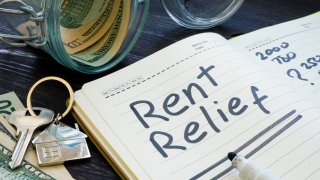
A nationwide ban on evictions will expire Saturday, putting roughly 3.6 million people in the U.S. at risk of being evicted from their homes in the next two months, according to the U.S. Census Bureau’s Household Pulse Survey.
The Biden administration said Thursday it would not extend a federal moratorium put in place last September by the Centers of Disease Control and Prevention, citing a recent Supreme Court ruling that signaled it could only be extended until the end of the month.
An estimated 8.8 million Americans are behind on their rent, according the Consumer Financial Protection Bureau. While relief efforts have staved off some of the housing crisis, rent is still going to come due.
More Rental Relief Coverage
Get top local stories in DFW delivered to you every morning. >Sign up for NBC DFW's News Headlines newsletter.
If you are at risk of being forced out of your home, here is what you should know about how to access this help:
What is the federal rental assistance program?
Congress passed two different rental relief packages. The first, approved in December, provided $25 billion for rental relief. The second, approved in March, provides more than $21 billion.
In general the aid can help pay for back rent, next month’s rent and some utility bills, including internet service. Renters can get a year or more’s help in getting caught up on back rent.
This is in addition to other programs out there on a local basis that may provide different forms of assistance. Renters who need help should reach out to their local housing authority to find out if they qualify for federal relief as well as any local aid.
How to apply for rental assistance
The National Low Income Housing Coalition has a state-by-state list of the 483 programs giving out the federal money.
The Consumer Financial Protection Bureau introduced this week its new Rental Assistance Finder, a search tool to quickly access more than 481 emergency rental assistance programs that local, state and tribal governments have launched nationwide.
The application can be made by the household in need or the landlord on behalf of the household. Usually the money will be paid directly to landlords and utility service providers.
However, some landlords may not want to participate because it requires a certain amount of paperwork and some concessions, such as potentially agreeing not to raise the rent or evict the tenant for a period of time. If a landlord does not wish to participate, funds may be paid directly to the eligible household.
How much financial help can I get?
The value varies from state-to-state, but you can receive up to 18 months of help with rent, including overdue rent, dating back to March 13, 2020. However, if you have overdue rent, the money must go toward rent that you owe before you are able to get help with future rent.
What other costs can rental assistance cover?
Rental assistance may also cover:
- Reasonable late fees (if not included in your rental or utility debt)
- Internet service to your home
- Moving expenses and other rental-related fees (such as security deposits, application fees, or screening fees) for families who have to move
- Cost of a hotel or motel room if you had to move out of your home and you don’t have a permanent home elsewhere
Do I qualify for rental assistance?
Eligibility is based on a renter household’s financial situation and housing needs
To be eligible for the funding, at least one member of your household has to qualify for unemployment benefits or has qualified, lost income or incurred significant debt due to the pandemic. You’ll also need to demonstrate a risk of homelessness, which may include a past-due rent or utility notice.
There is some flexibility for states to adapt the program, but in general, the federal relief money is available to those who earn 80% or less of the area median income in their area and have experienced some sort of COVID-related hardship. Preference is given to those with 50% or less of median income for their area.
Use this Area Median Income Lookup Tool to find the area median income in your area.
Know your rights
While the federal eviction ban is expiring, some states have extended their moratoriums. New York's eviction moratorium is extended until September for tenants who’ve endured a COVID-related setback. To qualify, renters must submit a hardship form to their landlord.
In New Jersey, families making less than 80% of their county median income are protected from eviction through Dec. 31, 2021 while those making more than 80% are protected until Aug. 31.
There is some concern demand for help may outstrip supply. So renters should act quickly or check back often if a program is not immediately available in their area. If a renter does not qualify for the federal relief money, they may be able to get help through other programs available in their area.
“The number one thing renters can do is make a plan,” said Susan Ifill, the chief operating officer at nonprofit housing organization NeighborWorks America. “Accessing those resources is one thing, but make a plan.”
That could include talking to a housing counselor or working with your landlord to develop a plan to repay rent or finding new housing.



